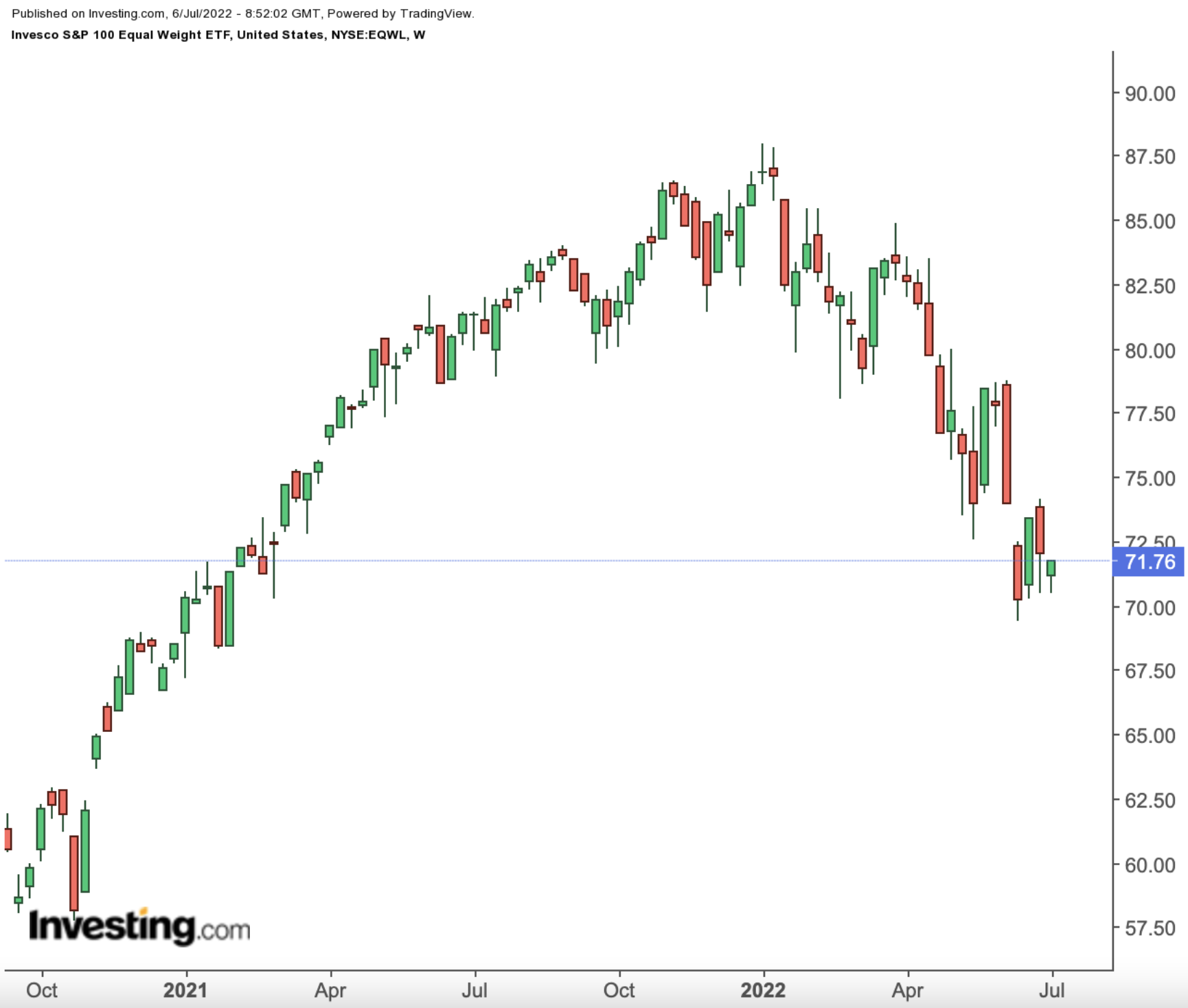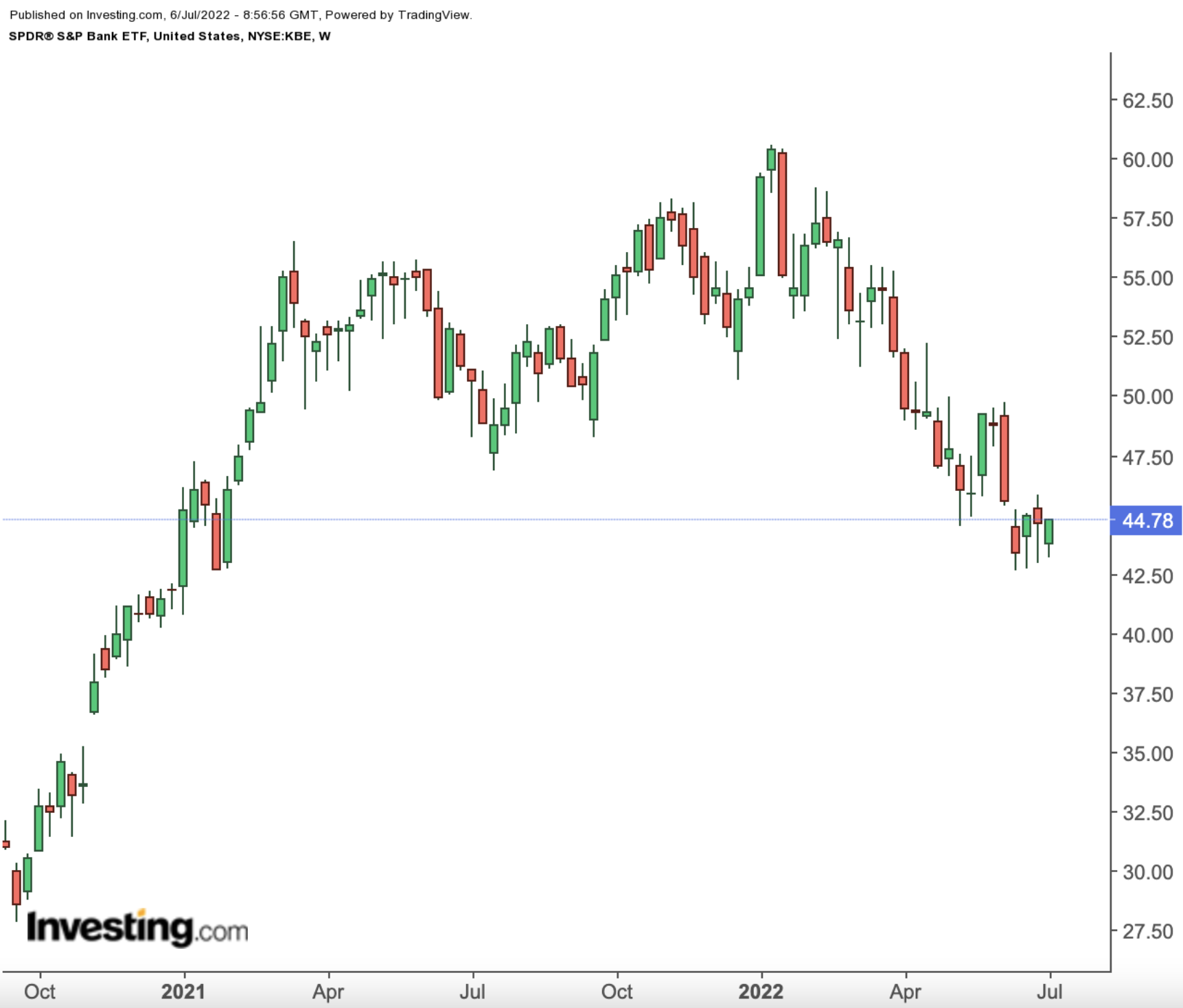Equal-weight exchange-traded funds (ETFs) invest roughly an equal percentage in each company within their portfolios, thus avoiding concentration. By doing so, these ETFs provide diversification and rebalancing benefits over their market-cap-weighted counterparts.
For instance, so far in the year, the SPDR S&P 500 (NYSE:SPY), which tracks the returns of the S&P 500 index, has lost about 20% of its value. By comparison, the Invesco S&P 500 Equal Weight ETF (NYSE:RSP) is down roughly 17%.
Similarly, the Invesco QQQ Trust (NASDAQ:QQQ), which tracks the NASDAQ 100 index, declined more than 30% year-to-date (YTD). On the other hand, the Direxion NASDAQ-100 Equal Weighted Index Shares (NYSE:QQQE) has lost about 26%.
Such a difference in percentage returns may be especially relevant during a busy earnings season--like the one about to start in the coming days.
Research highlights that with a compound annual growth rate (CAGR) of 19.6% from 1926 to 2021, U.S.-listed equal-weight ETFs have outperformed the market-cap-weighted funds by around 9.3%. The research report says:
“Broadly speaking, the drawdowns of our new equal-weighted portfolio and its market cap-weighted counterpart were similar. However, in five cases—in 1932, 1933, 1942, 1978, and 2002—they diverged by 10% or more. In each instance, the equal-weighted portfolio had smaller drawdowns.”
With that information, here are two equal-weight ETFs to research further in July:
1. Invesco S&P 100 Equal Weight ETF
- Current Price: $71.76
- 52-week range: $69.39 - $87.99
- Dividend yield: 2.25%
- Expense ratio: 0.25% per year
Our first fund is the Invesco S&P 100 Equal Weight ETF (NYSE:EQWL), which tracks the S&P 100 Equal Weight Index—an equal-weight version of the S&P 100 Index. The fund was first listed in December 2006.

In terms of sector allocations, we see information technology (15.67%), financials (14.97%), health care (14.81%), industrials (12.04%), and consumer staples (11.31%).
The top 10 stocks comprise almost 11% of $122.1 billion in net assets. Among them are Boeing (NYSE:BA), Eli Lilly (NYSE:LLY), FedEx (NYSE:FDX), AbbVie (NYSE:ABBV), Colgate-Palmolive (NYSE:CL), and UnitedHealth Group Incorporated (NYSE:UNH).
EQWL is down around 16.9% YTD. By comparison, the iShares S&P 100 ETF (NYSE:OEF), which tracks the S&P 100 index, has lost close to 22% since January.
In OEF, the top 10 holdings make up about 40% of the fund. Apple (NASDAQ:AAPL), Microsoft (NASDAQ:MSFT), Amazon (NASDAQ:AMZN), Alphabet (NASDAQ:GOOGL), and Tesla (NASDAQ:TSLA) are the leading names in that fund.
For EQWL, the trailing price-to-earnings (P/E) and price-to-book (P/B) ratios stand at 16.07x and 3.21x. On the other hand, for OEF, these two ratios are 18.78x and 3.96x.
We like the diversity of EQWL and believe it could appeal to readers wishing to tilt away from the technology sector while still desiring large-cap exposure during the earnings season.
2. SPDR S&P Bank ETF
- Current Price: $44.78
- 52-week range: $42.61 - $60.60
- Dividend yield: 2.85%
- Expense ratio: 0.35% per year
Next up on our list of equal-weighted funds is the SPDR S&P Bank ETF (NYSE:KBE), which invests in various financial names stateside. The fund was first listed in November 2005 and has over $2.1 billion in net assets.

KBE tracks S&P Banks Select Industry Index and currently holds 101 stocks. Around three-quarters of the portfolio is in regional banks (75.19%). Next, come thrifts & mortgage finance (12.29%), diversified banks (5.79%), other diversified financial services (4.43%), and asset management & custody banks (2.34%).
About 12.5% of the fund is in the leading 10 stocks. They include First Interstate BancSystem (NASDAQ:FIBK), Umpqua Holdings (NASDAQ:UMPQ), Texas Capital Bancshares (NASDAQ:TCBI), Truist Financial (NYSE:TFC), First Citizens BancShares (NASDAQ:FCNCA), and First Republic Bank (NYSE:FRC).
KBE has declined 17.9% since January. Trailing P/E and P/B ratios are at 9.33x and 1.10x. We find the valuations attractive and would consider investing around these levels for the long term.
